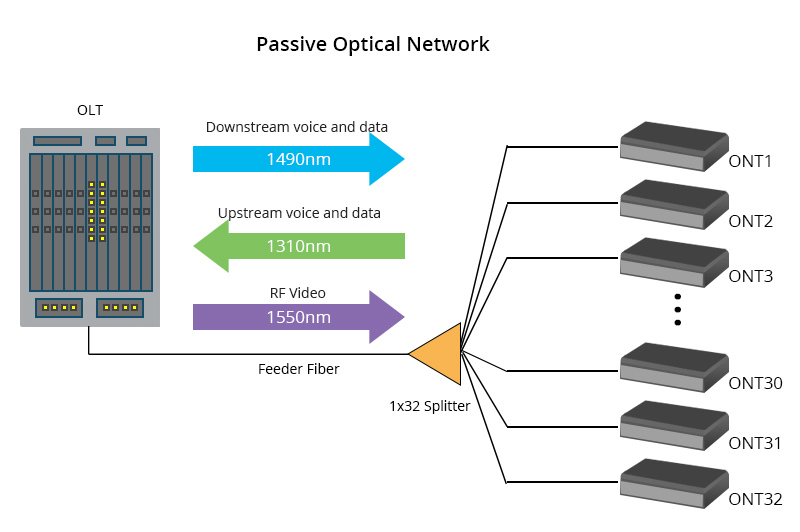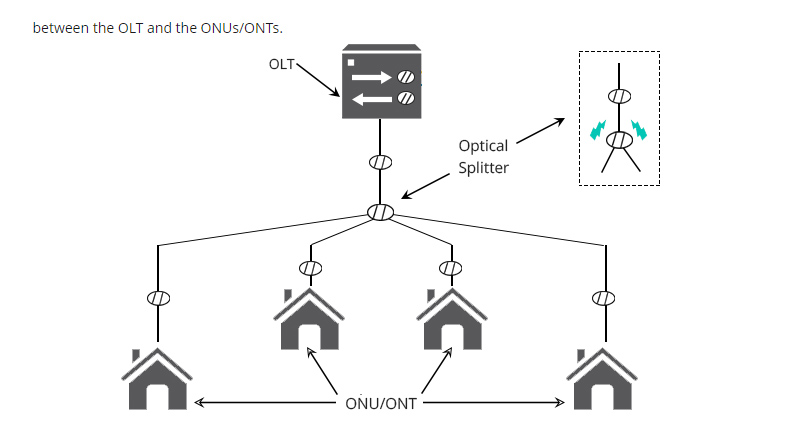Passive Optical Network Guide
Passive Optical Network (PON) technology is widely used by communication operators to offer optical fiber transmission for end consumers. The emergence of the PON network solves the bottleneck of users' access to bandwidth and ISP (Internet Service Provider) solves the problem of the last mile fiber to customers, this architecture has the advantages of high efficiency and cost-effectiveness performance. At the same time, there are many types of passive optical networks with different FTTx applications. The passive optical networks provide operators with innovative signal transmission methods. This article will give you a detailed highway network tutorial about passive optical networks.
Passive Optical Network Wiki
Different forms of optical fiber networks have different data transmission methods, the way of passive optical network transmission is point-to-multipoint topology. Optical splitters are used in the transmission process. Through the optical splitter, the data from the OLT will be transmitted to multiple ONT, meanwhile, the passive optical network can simultaneously transmit signals both upstream and downstream directions to and from end-users.

The biggest feature of the PON network is 'passive', which means this network is unpowered between the fiber and splitting/combining components. Furthermore, no electrical equipment is required in the PON system. The passive optical network is also more stable than the copper network link. When we use copper as a medium to transmit electrical signals, it will generate a lot of electromagnetic interference, which greatly increases the bit error rate. Using PON networks will gain more benefits in great signal integrity, of course, this can only come true within the rated transmission distance.
The WDM and TDMA Technology in PON System
The PON network can distinguish wavelengths, and the two wavelengths are responsible for upstream data transmission and downstream data transmission separately. The PON system use WDM (wavelength division multiplexing) technology, which is characterized by the ability to transmit the division signal flow. The data stream is separated by the passive optical network operations according to the laser wavelength(color). The PON network has many different standards, so each different standard has different dedicated wavelengths. When allocating uplink bandwidth for each user at the terminal or passive optical network splitter at a specific time, we need to use time division multiple access (TDMA) technology. Using TDMA technology can make the transmission more stable, and while multiple devices transmit data streaming, the data collisions won't be occupied at a terminal or PON splitter.
Passive Optical Network Architecture Wiki
Optical Line Terminal (OLT) and Optical Network Unit (ONU) or Optical Network Terminal (ONT) together form a PON system, where the OLT is located in the operator's central office, and the multiple optical network unit or optical network terminal is located close to the end-user. This optical link is connected by an Optical Distribution Network (ODN).

Passive optical networks can save a lot of fiber costs because the network system uses a point-to-multipoint (P2MP) transmission method, requiring only one fiber to connect to multiple endpoints from an operator, while a point-to-point architecture requires a separate optical fiber between each hub and the customer. A passive optical network can be built with only a few optical fibers and a central office through the point-to-multipoint transmission method.
Different Kinds of Passive Optical Network Types
With the different needs of the network, there are more and more different network topologies. The following part will introduce several mainstream passive optical network types.
APON/BPON
The letter A means ATM (Asynchronous Transfer Mode), the letter B means Broadband. APON system is the first passive optical network to be deployed commercially in the communication industry. Its transmission mode is ATM, and BPON as an enhanced version uses WDM downstream transmission. BPON has more dynamic bandwidth allocation and protection mechanisms than APON. Similarly, like an enhanced version, BPON is now more popular than APON. It is generally used in Ethernet access, video transmission, and High-speed leased lines.
GPON
GPON (Gigabit PON) adopts the ITU-T standard. This network is a new generation of broadband passive optical access. GPON can provide a high-bandwidth downlink rate of 2.5Gbps for network links. It also has asymmetric characteristics. To meet the needs of broadband data services, this standard is a carrier-class technology. At the same time, the GPON network can also protect the access network level and has a complete OAM function. This network is currently deployed on a large scale in the FTTH network.
EPON
The letter E in EPON stands for Ethernet. This network uses Ethernet packets, so it can be well compatible with Ethernet devices, this method has been proven to be feasible. At the same time, based on the IEEE 802.3 standard, EPON can connect devices without additional encapsulation and conversion protocols for the upstream and downstream transmission directions of the Ethernet network. Generally speaking, the transmission rate of EPON is 1.25Gbps symmetrical for both upstream and downstream. Therefore, when an IT Technician faces the choice of different data rates, split ratios, layering and access services, QoS, OAM, and costs, there are two mainstream choices of GPON vs EPON to meet their construction needs.
10G-E-PON
The working principle of this structure is the same as that of EPON. The 10G-E-PON standard is an enhanced version of EPON. Its upstream and downstream speeds can reach 10Gbps. In the downstream direction, its working wavelength is 1577nm. The working wavelength is 1270nm, which is different from EPON, so one PON device can be used for both E-PON and 10G-E-PON.
Why Do We Need to Use a Passive Optical Network?
Using a PON system allows for more efficient use of power due to the principle of not requiring a power supply. There is no need to install wiring closets, cooling infrastructure, or midspan electronics when installing the infrastructure. Both PON passive and active components have an easily identifiable feature that allows staff to save even more during maintenance and troubleshooting When faced with the pressure of upgrading the network, it is enough to replace the OLT, ONT, and ONU. These advantages allow the PON network system to reduce the budget when the operator builds the network.
Conclusion
With the development of PON network technology, service providers have a good choice when facing the bottleneck of "the last mile". According to the introduction of this article, you also know that passive optical networks are also valuable in terms of speed, energy consumption, reliability. If you have any questions about the PON network, you can consult QSFPTEK's technical support team via [email protected], QSFPTEK technical support team will provide you with very professional suggestions.










